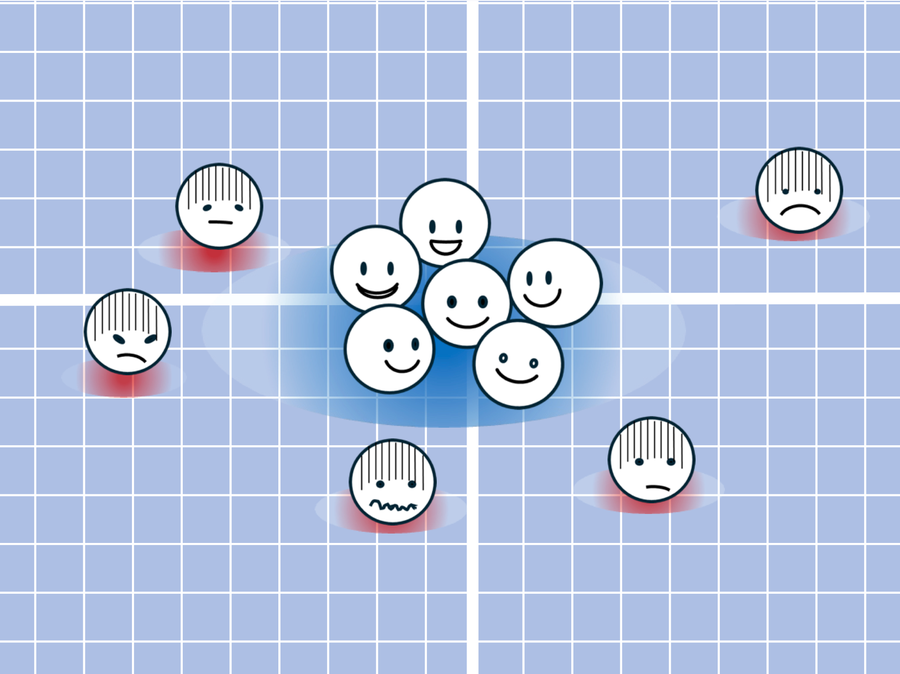- Tom Nichols on presidential pettiness;
- How the Trump administration is using a strength of science to discredit it;
- Ethan Siegel on what we’ve learned for 35 years of the Hubble Space Telescope;
- A breakthrough in a grand unified theory of mathematics;
- How brain scans reveal optimists are alike, and pessimists are unique; and my thoughts on whether this maps to conservative/progressive values.
Some sciency things today. Oh, OK, and a couple about Trump.
From Tom Nichols (whom I’ve reviewed and mentioned many times).

The Atlantic, Tom Nichols, 21 Jul 2025: Presidential Pettiness, subtitled “Donald Trump seems to have no theory of governance beyond personal gain and retribution.”
Years pass, Trump keeps doing the same thing, the commentators comment, pointing out the same things, and his fans don’t care, and nothing changes. But we can’t become complacent. People in the future will look back on this generation and see which people let Trump get away with all this. They will look back the same way they look back at the “good Germans” who supported Hitler.
So I will offer several paragraphs by Tom Nichols, and leave it at that.
Presidents are, like the rest of us, flawed human beings. Many of them had volcanic tempers: Harry Truman, Richard Nixon, and Joe Biden, among others, reportedly could sling Anglo-Saxonisms with gusto. In public, most of them managed to convey an image of geniality. (Nixon might be the exception there, but he embraced being an uptight square and his admirers found it endearing.) But all of them, regardless of their personality, had at least some notion about government, some sense of what they wanted to accomplish in the most powerful office in the world.
Donald Trump exhibits no such guiding belief. From his first day as a candidate, Trump has appeared animated by anger, fear, and, most of all, pettiness, a small-minded vengefulness that takes the place of actual policy making. It taints the air in the executive branch like a forgotten bag of trash in a warm house on a summer day—even when you can’t see it, you know it’s there.
Trump’s first run for office was itself a kind of petty tantrum. Trump had always wanted to run for president, a wish he expressed as far back as the 1980s. But Trump’s journey from pro-abortion-rights New York oligarch to anti-abortion Republican populist picked up speed after President Barack Obama humiliated him at the 2011 White House Correspondents’ Association dinner. Trump denies that Obama’s jibes moved him to run, but he jumped into the open GOP field once Obama’s two terms were coming to an end, and to this day, he remains obsessed with the first and only Black president—to the point that he misspoke on at least one occasion and said that he defeated Obama, not Hillary Clinton, to win his first term.
Trump’s second term has been a cavalcade of pettiness; his lieutenants have internalized the president’s culture of purges, retribution, and loyalty checks. Secretary of Defense Pete Hegseth’s insistence, for example, on renaming U.S. military bases after Confederate leaders has led to clumsy explanations about how the bases are now named for men who had names that are exactly like the 19th-century traitors’. This kind of explanation is the sort of thing that high-school teachers get from teenage smart alecks who think they’re being clever in class.
\\\
Now we slide from Trump to science.
 />
/>
The Atlantic, David Michaels and Wendy Wagner, 20 Jul 2025: Trump’s ‘Gold Standard’ for Science Manufactures Doubt, subtitled “By emphasizing scientific uncertainty above other values, political appointees can block any regulatory action they want to.”
Here’s a case where Trump and his acolytes take a strength of science and flip it to their own ends. We’ve seen this before (in Newitz and some other book I read recently). Scientists are very careful to acknowledge the strength of their cases, often statistically, and virtually never say that they have “proved” anything. Critics of science claim this as a weakness, and use it to their own advantage, the famous case being the cigarette manufacturers in the 1950s and 60s. If science can’t *prove* beyond the shadow of a doubt that smoking causes lung cancer, then they can go on selling cigarettes without government regulation. We’ve seen the same playbook with climate change and the fossil fuel companies.
The point is, science is never *certain*, but it works by virtue of consensus. Science doesn’t rely on faith — as naive religious critics think — it works by confidence, the confidence of all past results. That’s why quantum mechanics and evolution are as solid as any ideas in history. Or I should say: as any conclusions humanity has made about how reality works.
Late last month, the White House Office of Science and Technology Policy released a document detailing its vision for scientific integrity. Its nine tenets, first laid out in President Donald Trump’s executive order for “Restoring Gold Standard Science,” seem anodyne enough: They include calls for federal and federally supported science to be reproducible and transparent, communicative of error and uncertainty, and subject to unbiased peer review. Some of the tenets might be difficult to apply in practice—one can’t simply reproduce the results of studies on the health effects of climate disasters, for example, and funding is rarely available to replicate expensive studies. But these unremarkable principles hide a dramatic shift in the relationship between science and government.
Needless to say, Trump’s political appointees are not science oriented.
Political officials no longer need to rigorously disprove existing findings; they can cast doubt on inconvenient evidence, or demand unattainable levels of certainty, to make those conclusions appear unsettled or unreliable.
They know what they want to conclude, never mind the consensus of evidence.
In this way, the executive order opens the door to reshaping science to fit policy goals rather than allowing policy to be guided by the best available evidence. Its tactics echo the “doubt science” pioneered by the tobacco industry, which enabled cigarette manufacturers to market a deadly product for decades. But the tobacco industry could only have dreamed of having the immense power of the federal government. Applied to government, these tactics are ushering this country into a new era of doubt in science and enabling political appointees to block any regulatory action they want to, whether it’s approving a new drug or limiting harmful pollutants.
Humanity has learned much over the past centuries. But whether we can use that knowledge depends on the ideological trends of government, and of the priorities of big business, in a capitalist society.
\\\
Sciency things.

Big Think, Ethan Siegel, 21 Jul 2025: What we’ve learned after 35 years of NASA’s Hubble, subtitled “When the Hubble Space Telescope first launched in 1990, there was so much we didn’t know. Here’s how far we’ve come.”
Key Takeaways
• When the Hubble Space Telescope launched on April 24, 1990, there was so much we still didn’t know about the Universe. • We had never seen baby galaxies, exoplanets, didn’t know about dark energy, and had a 100% uncertainty in how fast the Universe was expanding. • Over the past 32 years, we’ve uncovered and discovered so much. Excitingly, in many ways, the journey to the beginning of the Universe is only getting started.
Many fascinating photos. Does any of this matter? Not to MAGA. To the progression of the human race? Definitely.
\\
This goes to abstruse ideas that even fewer people will care about, but is nevertheless an insight into the fundamental nature of existence.

Scientific American, Ananyo Bhattacharya & Nature magazine, 21 Jul 2025: Breakthrough Proof Brings Mathematics Closer to a Grand Unified Theory after More Than 50 Years of Work, subtitled “The Langlands program has inspired and befuddled mathematicians for more than 50 years. A major advance has now opened up new worlds for them to explore”
I have no clue what the Langlands programme is about —
One of the biggest stories in science is quietly playing out in the world of abstract mathematics. Over the course of last year, researchers fulfilled a decades-old dream when they unveiled a proof of the geometric Langlands conjecture — a key piece of a group of interconnected problems called the Langlands programme. The proof — a gargantuan effort — validates the intricate and far-reaching Langlands programme, which is often hailed as the grand unified theory of mathematics but remains largely unproven. Yet the work’s true impact might lie not in what it settles, but in the new avenues of inquiry it reveals.
— but apparently it goes to the idea of whether mathematics is embedded in the reality of the universe, or whether it’s a local model of reality created by the human mind.
\\
One more.

Scientific American, Allison Parshall, 21 Jul 2025: Optimists Are Alike, but Pessimists Are Unique, Brain Scan Study Suggests, subtitled “Optimists have similar patterns of brain activation when they think about the future—but pessimists are all different from one another, a brain scan study suggests”
“All happy families are alike; each unhappy family is unhappy in its own way.” This is the first line of Leo Tolstoy’s novel Anna Karenina, and it may hold a kernel of truth that goes beyond family dynamics. In a recent study of optimism, neuroscientists found an equivalent principle at play: optimists shared similar patterns of activity in a key brain region when they imagined future events, but each pessimist’s brain patterns was unique. The results help neuroscientists understand what distinguishes optimism from pessimism in the brain. This is an important question because optimism is associated with better physical, mental and social health. The results were published on Monday in the Proceedings of the National Academy of Sciences USA.
What intrigues me here, though the article does not address this, is whether optimism and pessimism can in any way aligned to conservative or progressive values. Off-hand, I would think conservatives are pessimistic, since they’re always worried about how society is going to hell because of change; while progressives, who understand that things change and that problems can be solved, as they’ve been solved for thousands of years, are optimistic, because human history has shown progress. We are not in a place that conservatives of any era would have wished us to stay in.





